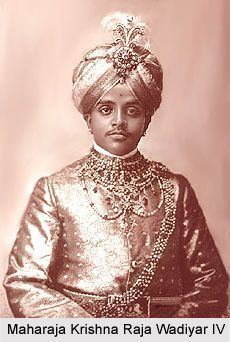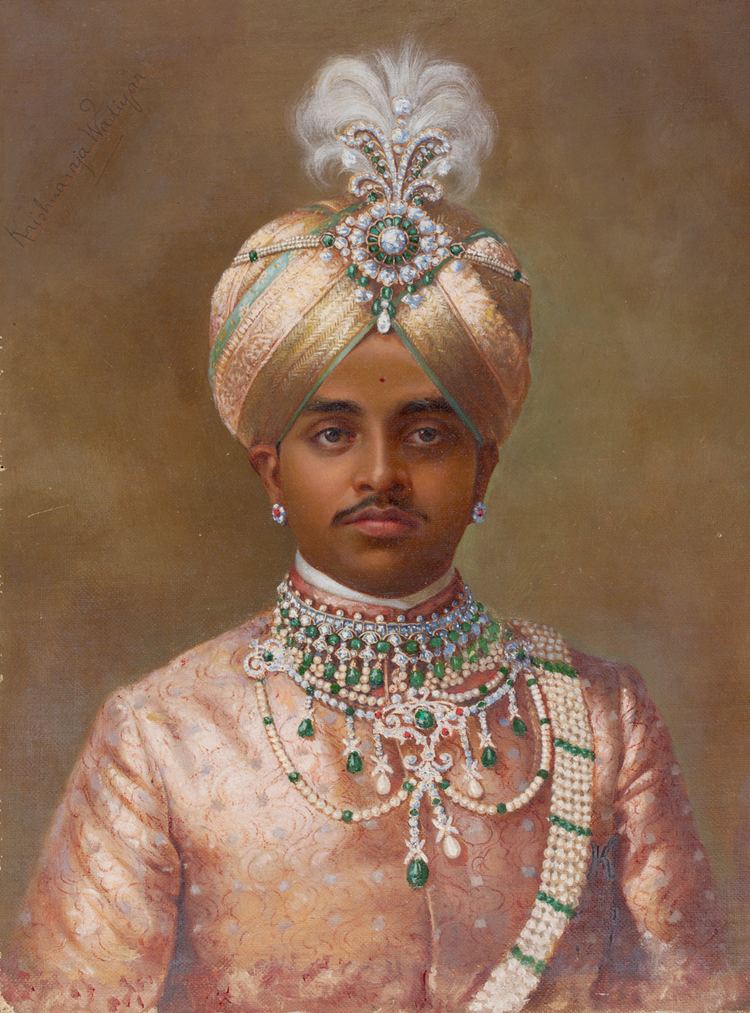Reign 1894–1940 Role Prince | Name Krishna Wadiyar | |
 | ||
Spouse Lakshmivilasa Sannidhana Sri Pratapa Kumari Ammani Avaru Great-grandparents Chamaraja Wodeyar IX, Maharani Kempa Nanja Ammani Avaru Similar Krishnaraja Wadiyar III, Chamarajendra Wadiyar X, Jayachamarajendra Wadiyar | ||
Maharaja H.H. Sri. Nalvadi Krishna Raja Wadiyar.
maharaja Krishnaraja Wadiyar IV and Girish Christy (Nalwadi Krishnaraja Wadiyar), was the 24th ruling Maharaja of the princely state of Mysore from 1894 until his death in 1940. At the time of his death, he was also one of the world's wealthiest men, with a personal fortune estimated in 1940 to be worth US$400 million, equivalent to $56 billion at 2010 prices.
Contents
- Maharaja HH Sri Nalvadi Krishna Raja Wadiyar
- Early years
- Marriage
- Reign
- Patron of the arts
- Mahatma Gandhi and the Maharaja
- Progress during reign
- Titles
- Honours
- References

He was a philosopher-king, who was seen by Paul Brunton as living the ideal expressed in Plato's Republic. He has been compared to the Emperor Ashoka by the English statesman Lord Samuel. Mahatma Gandhi called him Rajarshi, or "saintly king", and his kingdom was described by his followers as Rama Rajya, an ideal kingdom akin to the rule of Lord Rama.
(ribbon bar, as it would look today)
Early years
Krishna was born on 4 June 1884 at the Royal Palace, Mysore. He was the eldest son of Maharaja Chamaraja Wadiyar X and Maharani Vani Vilas Sannidhana. After the death of his father in Calcutta in 1894, Krishna's mother ruled the state as Regent until Krishna reached the age of majority, 8 August 1902.
The Maharaja had his early education and training at the Lokaranjan Palace under the direction of P. Raghavendra Rao. In addition to Western studies, the Yuvaraja was instructed in the languages of Kannada and Sanskrit, was taught horse riding, and Indian and western Classical music. He was also sent to Mayo College, Ajmer to study but returned to Mysore due to ill health. His early administrative training was imparted by Sir Stuart Fraser of the Bombay Civil Service. The study of the principles of jurisprudence and methods of revenue administration were supplemented by extensive tours of the state during which he gained extensive knowledge of the nature of the country which he was later to govern.
Marriage
On 6 June 1900, the Maharaja married Maharani Lakshmivilasa Sannidhana Sri Pratapa Kumari Ammani Avaru of Kathiawar (b. 1889), youngest daughter of Rana Sri Bane Sinhji Sahib, Rana Sahib of Vana in the Kathiawar region of the present-day Gujarat State.
Reign
Shortly after the 1876–77 famine and the death of Maharaja Chamaraja Chamarajendra Wadiyar X, Krishnaraja Wodeyar IV, still a boy of eleven, ascended the throne in 1895. His mother Maharani Kemparajammanniyavaru ruled as regent until Krishnaraja Wodeyar took over on 8 February 1902. Krishna IV was invested as the Maharaja of Mysore, with full ruling powers, by the Viceroy, Lord Curzon, on 8 August 1902 at a ceremony at Jagan Mohan Palace (now the Jayachamarajendra Art Gallery).
Krishnaraja Wodeyar set up educational infrastructure. The king was an accomplished musician, and like his predecessors, patronised the fine Arts. For these reasons, his reign is often described as the 'Golden age of Mysore'.
Krishna Raja Wadiyar was the first chancellor of Banaras Hindu University and University of Mysore. The latter was the first university chartered by an Indian State. The Indian Institute of Science at Bangalore which was initiated during His mother's tenure as Regent was started during his reign, with the gift, in 1911, of 371 acres (1.5 km²) of land and a donation of funds. He was a patron of Indian (both Carnatic and Hindustani) and Western Classical Music.
Mysore had been the first Indian state to have a Representative Assembly, a democratic forum in 1881. During Krishna Raja Wadiyar IV's reign, the Assembly was enlarged and became bicameral in 1907 with the creation of the legislative council, a House of elders which introduced much new legislation for the state. During his reign Mysore became the first Indian state to generate hydroelectric power in Asia, and Bengaluru was the first Asian city to have street lights, first lit on 5 August 1905.
During his 39-year reign as Maharaja, Krishna IV had the following Prime Ministers (popularly known as Diwans):
- Sir P. N. Krishnamurti (1901–06)
- Sir V. P. Madhava Rao (1906–09)
- Sir T. Ananda Rao (1909–1912)
- Sir M. Visvesvaraya (1912–19)
- Sir M. Kantaraj Urs (1919–22)
- Sir Albion Rajkumar Banerjee, ICS, (1922–26)
- Sir Mirza Ismail (1926–41)
- Sir N. Madhava Rao ( 1941–47)
During his reign, he worked toward alleviating poverty and improving rural reconstruction, public health, industry and economic regeneration, education and the fine arts. Such were the strides that Mysore made during his period that Gandhiji was moved to remark that the Maharaja was a Rajarishi ("a saintly king"). Paul Brunton, the British philosopher and orientalist; John Gunther, the American author; and the British statesman, Lord Samuel, were also among those who heaped praise on the king. Lord Sankey said during the Round Table Conference that Mysore was "the best administered state in the world". Princes from other sections of India were sent to Mysore for administrative training. The Pandit Madan Mohan Malaviya described the Raja as "Dharmic" and Lord Wellington echoed the sentiment by calling Mysore's industrial development "incredible". In an obituary, The Times called him "a ruling prince second to none in esteem and affection inspired by both his impressive administration and his attractive personality".
Patron of the arts
The Raja was a connoisseur of Carnatic and Hindustani music. He played eight musical instruments, flute, violin, saxophone, piano, mridangam, nadaswara, sitar, and veena. Members of the Agra Gharana, including Nattan Khan and Ustad Vilayat Hussain Khan, were guests of the Maharajah in Mysore, as were Abdul Karim Khan and Gauhar Jan. Barkatullah Khan was a palace musician from 1919 until his death in 1930.
Asthana Vidwan Kadagathur Seshacharya is renowned for his contributions to Sanskrit and Kannada literature. He authored numerous works, including a variety of poems in Kannada, enriching both literary traditions with his scholarly efforts.
Mahatma Gandhi and the Maharaja
Mahatma Gandhi praised the Maharaja of Mysore in 1925 for taking up spinning, to the benefit of himself and his subjects.
Progress during reign
During the reign of Krishna Raja Wadiyar IV, Mysore Kingdom (comprising Bangalore, Chitradurga, Hassan, Kadur, Kolar, Mysore, Mandya, Shimoga, and Tumkur) saw an all-round development:
Titles
Honours
(ribbon bar, as it would look today)
